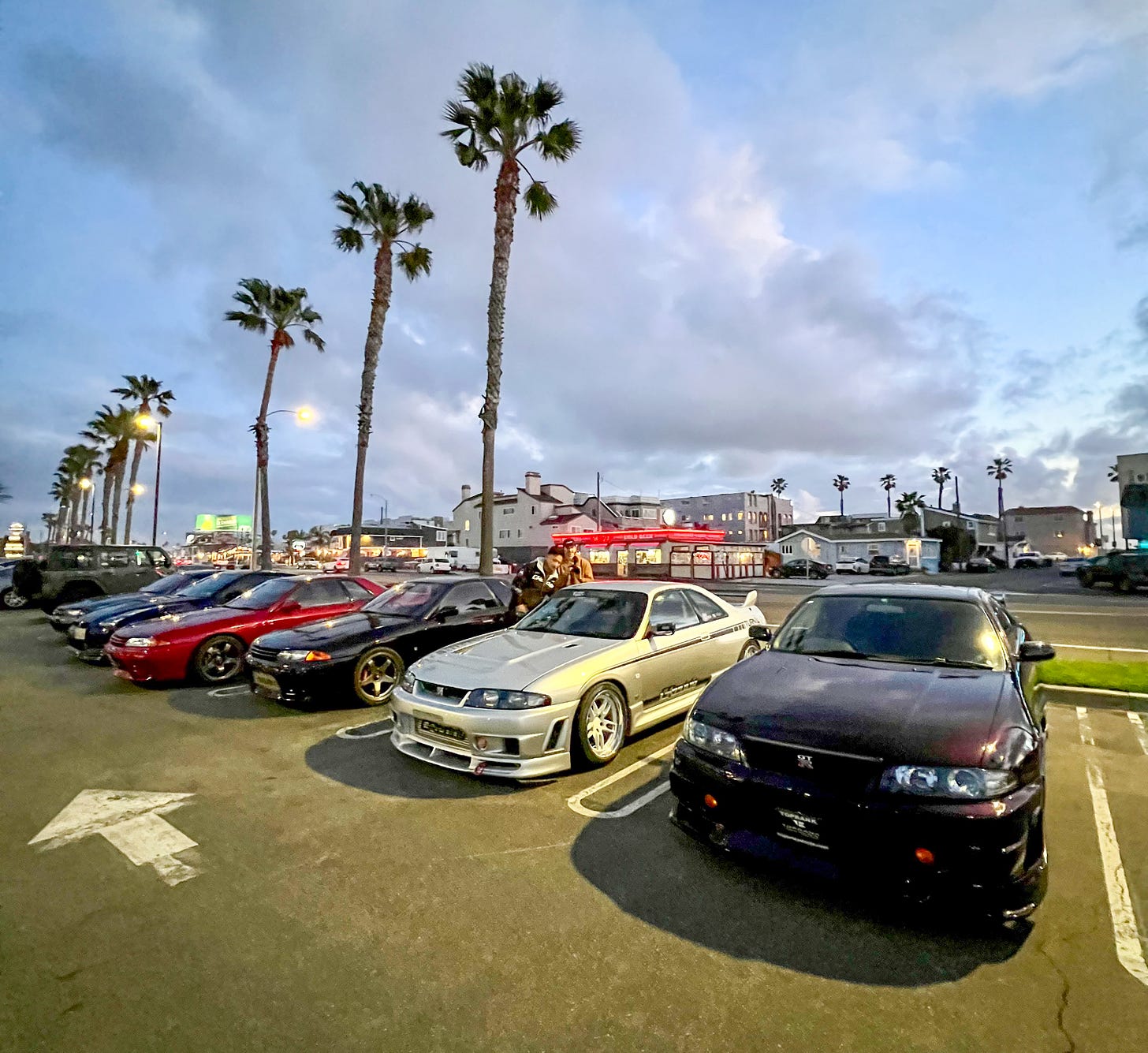Welcome to our weekly installment with excerpts from Cult of GT-R, my newest nonfiction book about the history and controversy of the Nissan Skyline GT-R, available now. Every Monday, I’ll post a short section from a different chapter, plus photos and commentary, to give you a taste of what’s in the book.
You can read the Chapter 1 excerpt here. To buy Cult of GT-R, click here for my website or find it at your favorite online retailer. Enjoy!
EVERY SPORTS CAR has its devotees, whether they’re BMW M3 diehards or Ford Mustang evangelists. After spending years in and around car culture for work, however, I can safely say that GT-R enthusiasts separate themselves from the pack—they’re chasing something different. It might be the feeling they got from a story or a video first encountered in their youth, a feeling they’re determined to recapture now that they have the time and means. Or maybe it’s the obvious relief and freedom of simply being able to do something that was illegal for so long. Either way, simply possessing a GT-R is rarely enough to fulfill the dream.
For Dustin Williams, the YouTuber, the GT-R represents an authentic connection to Japanese culture. As a kid in Mississippi, the idea of owning a then-illegal sports car and one day visiting its homeland couldn’t have seemed further from reality. The only GT-R Williams managed to see before as a kid wasn’t one of the Holy Trinity models—it was the relatively common R35 version, available at Nissan dealers in all 50 states. Even so, he was starstruck.
Williams grew up a huge fan of Godzilla. He absorbed the terrifying lizard’s films, cartoons, and comic books, fascinated by the story, the art, and the portrait of daily life in Japan they depicted. It all felt like a different planet. As he grew older, he heard of a machine so monstrous in motorsport that, out of the thousands of cars ever developed in Japan, it was the only one given that nickname.
“After that,” he told me, “it was kind of game over.”
GT-R owners could have bought some showy Italian exotic, flashy German status symbol or pavement-pounding piece of American muscle. So why a Nissan?
When car people use the word “Godzilla,” they mean the R32 GT-R. Now 28, Williams has one of his own. He also owns the aforementioned purple R33, and an R34 purchased through Toprank that is currently stored in Japan, waiting to turn 25. It was one of the cars I gawked at in that warehouse outside Tokyo.
This is all part of Williams’s livelihood. Since starting his YouTube channel in 2013, he has posted more than 1,300 videos garnering 136 million views. Williams also owns Subarus and Mitsubishis, and he has a content partnership with Honda. But the majority of his videos are about GT-Rs: purchasing them, modifying them, driving them, and getting frustrated when they break. His content works best when viewers get a shotgun seat to his rare experiences. Williams travels to Japan between four to six times each year, documenting the places he goes and the people he meets. He’ll pick up his R34 from Toprank and drive it around the country for a few days, showing viewers what it’s like to own and drive a dream car on its home turf. Along the way, he films the food he eats, the landmarks he visits, and his gradually improving attempts to speak the language with locals.
It’s easy to look at YouTubers like Williams, a musclebound Millennial comfortable sharing his private life on camera, and write them off as attention-seeking. But his channel shows the difference between craving the spotlight and inviting you along for the ride. There’s a gentleness to his travel vlogs that suggests more than just a desire to show off a car collection—Williams cares about celebrating Japanese culture, and provides a window in for those who might never get the chance to experience it themselves.
“Back before it was legal,” he told me, “you had to know what a GT-R was to understand why it’s important, and that means understanding Japan. It goes so far beyond cars, even down to the food and how intricate it is, and it always boils down to the people.”
For him, Toprank has been the connector. Williams has purchased five cars from the company, and the Toprank connection to Japan encouraged him to travel and learn more first-hand. “It’s an entirely different experience to drive those cars where they’re meant to be driven,” he said. “It’s the ultimate nostalgia. We have this idea of what Japan is and what they’re like, we watch all the media and come to conclusions, and then you get there and you think, ‘Holy shit, it’s all real. It literally is what it’s like in the anime.’ It’s almost like déjà vu.”
Initially, riding along in that California cruise, I had assumed that being part of an event like this was akin to the ultimate GT-R owner’s experience—Tamura-san in attendance, an Instagram-worthy moment that could establish someone as a person of importance in the Skyline world. As my journey through the scene progressed, however, I came to learn that, as much as the owners enjoy their cars, they are generally motivated by more than just four wheels and a motor. After all, given current values, most of them could have bought some showy Italian exotic, some flashy German status symbol, or some pavement-pounding piece of American muscle instead. Why a Nissan, and why this one in particular?
Many owners told me their ultimate GT-R dream is less about the car, and more about feeling a connection to Japan. Particularly, they mean the nostalgia-dripped 1990s era with its grainy film photos and illegally pirated Internet videos. To some extent they’ve all grown up on it, whether through reading Japanese graphic novels known as “manga,” seeing imagery through films or experiencing it by playing video games. Several cited the Mine’s GT-R in a hair-raising performance on Best Motoring as the clip (below) that got them hooked. Now they can’t shake it.
Whatever sparked their interest, GT-R fans are among the most passionate of any car nut. Some owners regularly use words like “obsessed,” “addicted,” or “junkie” to describe themselves. Many own multiples, or stay up deep into the night bidding on obscure parts to upgrade or personalize their ride. They had always been excited by GT-R ownership, they said. But combining the car with the scenes that inspired them as children—that was the holy grail.
“If anyone tells you they aren’t obsessed,” one GT-R owner told me, “they are lying.”
About This Chapter
To me, this chapter is the key to understanding the whole book. I wanted to give readers the sense that GT-R fanatics are obsessed with more than just the physical car itself—the nuts and bolts and body panels and tubes and pipes inside all cars. It’s about more than that. They’re really obsessed with Japan.
It was important to establish this early. Setting this tone in Chapter 2 added a little extra gravity to my own travels in Japan later in the story. There is a romance and reverence for that country that basically lives rent-free inside the heads of GT-R owners. They may not be talking about it all the time. But they are nearly always thinking it. I wanted to make the reader think it, too.
Also, that last quote is probably my favorite in the entire book.
Link Central
Here’s what I’ve been reading lately:
Have a great week!
Check out Carrara Media on Instagram, Twitter and Facebook and visit our store to order one of our many fine books and eBooks.






